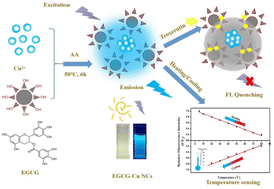Green synthesis of fluorescent copper nanoclusters stabilized by epigallocatechin gallate and their applications as a novel troxerutin (trihydroxyethylrutin) and temperature sensor†
Abstract
A facile one-pot approach to synthesize copper nanoclusters (Cu NCs) using epigallocatechin gallate (EGCG) as a stabilizing agent for the first time is reported in this study. The prepared blue-emitting EGCG–Cu NCs were uniform in size and were quite stable. Significantly, the prepared EGCG–Cu NCs were first used to detect troxerutin (trihydroxyethylrutin). The EGCG–Cu NCs were efficiently and selectively quenched by troxerutin, as a result of the inner filter effect (IFE). The detection limit was 0.34 μM in the range of 1–200 μM. This novel troxerutin sensor was used successfully to detect troxerutin in real samples of troxerutin tablets and injections with satisfactory recoveries. Additionally, the fluorescence of EGCG–Cu NCs responded to the changes in temperature. The EGCG–Cu NCs showed a good linear relationship, reversibility, and reproducibility under heating and cooling treatments in a wide range from 5 to 80 °C, which may enable them to be employed as a smart nanothermometer.



 Please wait while we load your content...
Please wait while we load your content...